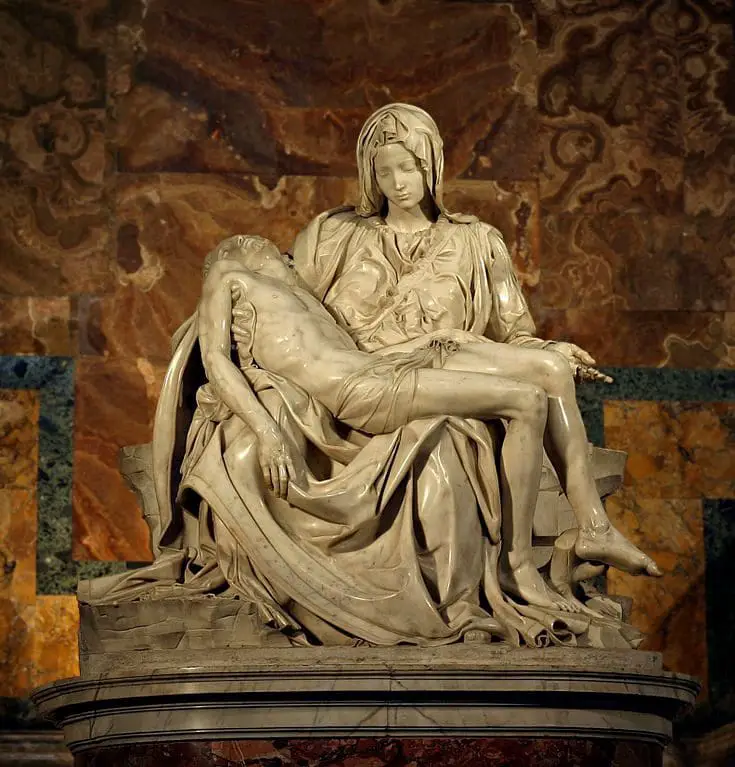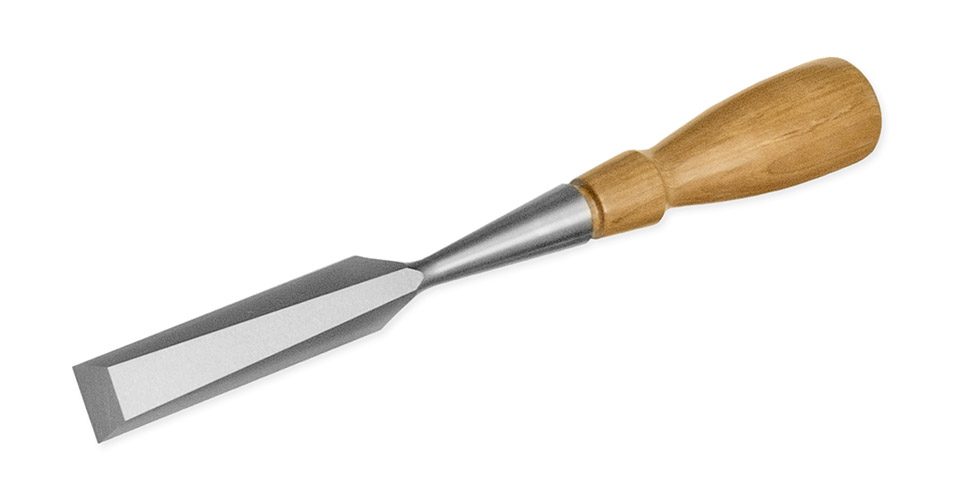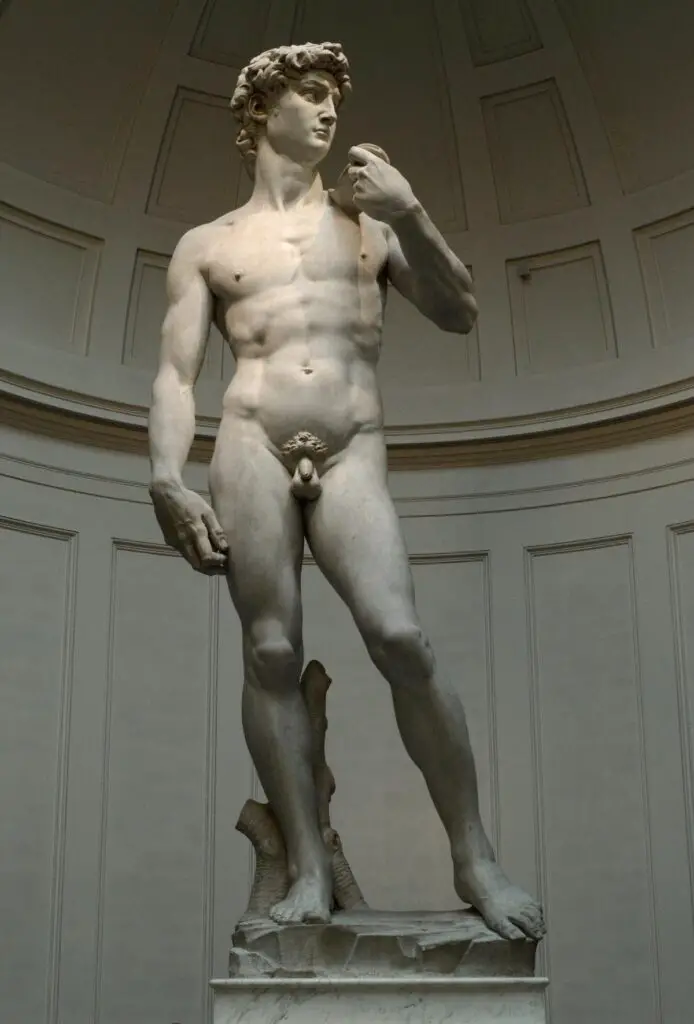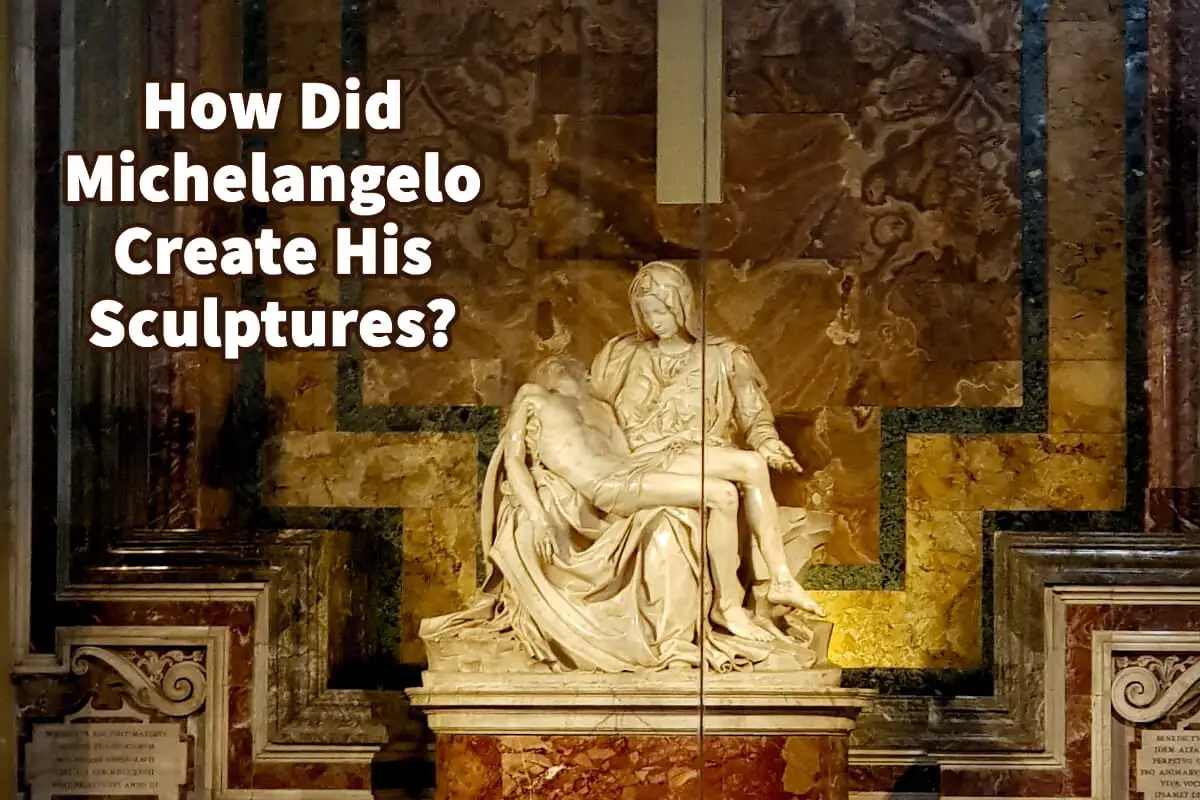Michelangelo is one of the greatest artists of the Renaissance era. Though he is known best for his fresco painting of the Sistine Chapel ceiling, he always considered himself a sculptor.
Michelangelo was a master with his sculptures. He was a master at invoking emotions and details with his work; he could do all this from a piece of white Carrara Italian marble using a chisel and mallet. He would have had sketches and models that he worked from as he carved the massive marble stone.
Table of Contents
Michelangelo’s Process To Create Sculptures
Michelangelo was no doubt a master sculptor to be able to take a piece of white Carrara marble and then see and understand how to carve the raw marble into a masterful sculpture. What is unique about his sculptures is the amount of detail he could put on them.

The sculptor Pieta by Michelangelo depicts Jesus’s mother, Mary, carrying her son, Jesus, after being crucified on the cross. The detail of both Mary and Jesus is fantastic. Jesus’s body lays limb and lifeless, yet we can see Christ’s ribs and muscles in his legs.
Mary’s clothes are folded as Christ is wrapped over her lap. The Pieta statue shows how masterful Michelangelo was to depict such detail and emotion from a Carrara Italy white marble slab.
Tools Used to Carve Michelangelo’s Sculptures
Here is what Michelangelo used to carve his sculptures:

- Carrara Marble – Carrara marble, also known as Luna marble to the Romans, is a white or blue-grey marble famous for sculptures and decorating. It was quarried since Roman times, just outside Carrara, Italy.

- Chisels – The chisel is an extended hand tool with a bevel cutting edge and a plain handle that can be struck with a mallet and cut away the marble. He probably used a point chisel, a tooth chisel (rake), and a flat, straight chisel.

- Mallets – A mallet is a hammer that would have been used to pound on top of the chisel, so he cut away at the marble.
Most people believe that Michelangelo used only these essential tools for his sculptures. Some people claim that he used the pointing machine to carve his statues, but in France, pointing machines were invented in the mid-18th century. Michelangelo lived before these machines were designed.
Method Michelangelo Used To Create His Sculptures

Here are some methods Michelangelo would have used to carve all his statues:
- Detailed Sketch And Design – Michelangelo would have needed to have a detailed sketch or design. Many believed that Michelangelo was gifted with photogenic memories, so he could easily remember all his illustrations and designs.
- Clay Model – Recently, some clay models believed to be Michelangelo’s clay models of his sculptures have been discovered. Michelangelo would have likely worked from a clay or wax model of what he would carve.
- Terracotta Model – Once he had the clay or wax model perfected, he would make a terracotta model to be presented and shown to the art patron. The plaster could have been used to make the terracotta model or its basis.
- Smaller Models – Sometimes, Michelangelo would cut a smaller model out of marble before cutting a large-scale model. This would have allowed him to study the model thoroughly.
- Wax Model – Michelangelo could have also done some lifesize wax models. This would have allowed him to use what was known as the water method. The marble and wax model was placed in water, and the water was lowered as the carving was done. This allowed him to be sure to get the carving correct.
- Pick The Marble Slab – An essential aspect of the carving would have been to pick a suitable marble slab. The marble piece must be the right size, quality, and color. He would not have wanted to see apparent flaws or issues, and we assume he ensured that suitable marble was picked for the statue.
- Transport The Marble – Marble is extremely heavy, and even today, with all our modern equipment, it is not easy to transport. This would have been extremely difficult during the 15th and 16th centuries; having the marble moved to a location or studio where he could adequately work on the marble piece was necessary.
- Basic Outline On Marble – Once he had the marble and the models all approved, he would start to paint and outline on the marble or block out the marble.
- Crosshatching – Michelangelo was known to carve his statues as he did his drawing with a technique known as crosshatching. Crosshatching was about carving up and down and then side to side in a cross pattern.
- Zero In On Torso First – It was said that usually, Michelangelo would zero in on the torso section of the statue first. Michelangelo had an excellent knowledge of the human body and proportions to usually judge exactly where the torso should be on the marble piece.
- Carved Rest Of Statue – Once he got the torso done, he could proportionally sculpt the rest of the body or the statue.
- Using Assistants – In working with marble, a lot of hard work must be done to chisel away large chunks of the marble. Michelangelo probably also had other sketches, models, and details so that assistants could help him with some of these process parts.
After Michelangelo roughly sketched where he wanted the statue to be, he would probably use a point chisel to chisel away some of the larger stone areas he did not need or want. Then he probably used a toothchisel as this would have allowed him to model and carve the stone.
He would have then refined his carving and his work. He uses other chisel tools to do all the detailed work on the statue. Michelangelo would have done all the detailed work to ensure it was right.
We know that Michelangelo would use models for his carvings as some of the terracotta models were given away, or he would use wax models to cast bronze of the same statue. Some bronze models, such as the Medici Madona statue, still survive today. Michelangelo presented this bronze to the Archbishop of Florence, Giovanni Salviati, and the statue remained with the family until 1830.
Anita Louise Art is dedicated to art education, great artists, and inspiring others to find and create their art. We love art that uplifts and inspires. #ArtToMakeYouSmile! #ArtToMakeYouHappy!
If you want to see any of my art, you can find out more by clicking here. If you are interested in what inspires me and my paintings, you can discover more by clicking here.
We have a free newsletter and would love you to be part of our community; you can subscribe to the newsletter by clicking here. If you have any questions, I would be happy to talk to you at any time. You can reach me, Anita, by clicking here.
Subscribe to our Anita Louise Art YouTube Channel with great videos and information by clicking here.
Join us for our podcast “5 Minutes With Art.” Spend 5 minutes a week with us to discover and learn about great art and artists. You can find out more about our podcast by clicking here.
Frequently Asked Questions
What materials did Michelangelo use for his sculptures?
Michelangelo primarily used Carrara Italian marble for his sculptures. This high-quality, white marble was favored by Renaissance artists for its purity and workability.
Did Michelangelo use any tools other than chisels and mallets?
While chisels and mallets were his primary tools, Michelangelo also used rasps, files, and other carving tools to achieve intricate details and smooth surfaces in his sculptures.
Did Michelangelo create sketches or models before sculpting?
Yes, Michelangelo meticulously planned his sculptures by creating detailed sketches and small-scale models. These served as references and guides as he worked on the larger marble blocks.
How did Michelangelo choose his subjects for sculptures?
Michelangelo often drew inspiration from classical mythology and biblical stories. He selected subjects that allowed him to explore the human form, emotions, and spiritual themes in his sculptures.
What was Michelangelo’s carving process like?
Michelangelo’s carving process involved removing excess material from the marble block to reveal the intended form. He began with rough shaping using larger tools and gradually refined details as the sculpture took shape.
Did Michelangelo work alone on his sculptures?
While Michelangelo was known for being highly independent and hands-on, he did have assistants who helped with various aspects of the sculpting process. However, the final touches and overall design were always under his direct supervision.
How did Michelangelo achieve such realistic details in his sculptures?
Michelangelo’s keen observation of the human anatomy, combined with his exceptional skill, allowed him to carve realistic details such as muscles, veins, and facial expressions. His ability to capture the essence of the human form set him apart.
Why did Michelangelo prefer working with marble over other materials?
Michelangelo admired the purity and luminosity of Carrara marble, which he believed enhanced the divine and timeless qualities of his sculptures. The challenge of working with such a demanding material also appealed to his artistic sensibilities.
How did Michelangelo approach the emotional aspects of his sculptures?
Michelangelo infused deep emotions into his sculptures by conveying a sense of movement, tension, and drama. Through careful attention to posture, expression, and composition, he brought his stone figures to life with a powerful emotional impact.
Did Michelangelo face any challenges while sculpting?
Working with marble presented numerous challenges, including its hardness and unpredictability. Michelangelo often had to adapt his designs based on the unique characteristics of each block. Additionally, the physical demands of sculpting large pieces required immense strength and endurance.
Related Questions
Michelangelo’s Sistine Chapel And His Payment
Michelangelo was paid 3200 gold ducats for his work on the ceiling of the Sistine Chapel, which would have been a very lucrative commission. We know he stopped work on the ceiling for a while due to his not being paid by the Vatican. Michelangelo liked to give the impression that he was a very poor artist, but records have shown that he died an extremely wealthy man.
By clicking here, you can learn more by reading Michelangelo’s Sistine Chapel And His Payment.
Did Michelangelo And Leonardo Know Each Other?
Michelangelo and Leonardo da Vinci knew each other but were considered bitter rivals. Leonardo da Vinci and Michelangelo knew each other, but they did like each other. They were both asked to do a commission on the Council Hall of the Palazzo Vecchio and were supposed to work side-by-side; the project was never completed.
By clicking here, you can learn more by reading Did Michelangelo And Leonardo Know Each Other?.
Michelangelo’s Method To Paint The Sistine Chapel Ceiling
He built a large scaffolding structure that could move around the chapel to paint the ceiling; the painting of the Sistine Chapel was an extremely strenuous work that was a huge personal cost both physically and mentally to Michelangelo.
By clicking here, you can learn more by reading Michelangelo’s Method To Paint The Sistine Chapel Ceiling.

